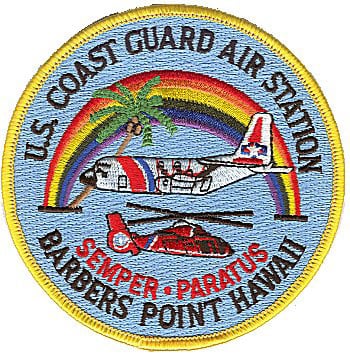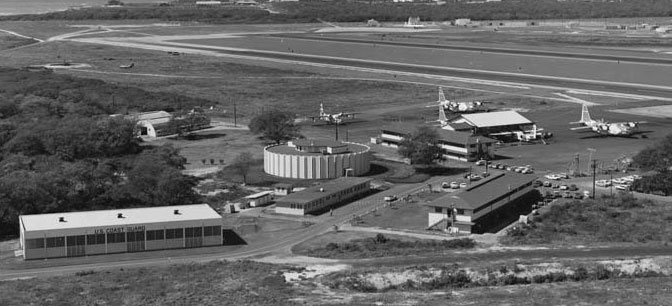 The first permanent Coast Guard aviation unit in the Hawaiian archipelago became reality in 1945 when LT Ben Dameron was assigned command of eighteen enlisted personnel and five officers located at the Naval Air Station Kaneohe. NAS Kaneohe, located on the windward side of Oahu, was a major advanced training base for Pacific operations during World War II. The Coast Guard Air detachment, consisting of a PBY-5A and one JRF, was established to provide air-sea rescue services. The JRF was retained but the PBY was replaced by two P4Y-2s Privateers. The P4Y-2s were also used for Pacific supply runs. The runs went from Kaneohe to the MATS terminal at Hickam Field, then Johnson Island, Majuro, Kawjelien, Guam, Sangley Point to Japan and then back through Wake, and Midway. The trip took between 20 and 28 days and the route varied. The detachment transported everything that ATC or MATS would not carry and went to places they did not go.
The first permanent Coast Guard aviation unit in the Hawaiian archipelago became reality in 1945 when LT Ben Dameron was assigned command of eighteen enlisted personnel and five officers located at the Naval Air Station Kaneohe. NAS Kaneohe, located on the windward side of Oahu, was a major advanced training base for Pacific operations during World War II. The Coast Guard Air detachment, consisting of a PBY-5A and one JRF, was established to provide air-sea rescue services. The JRF was retained but the PBY was replaced by two P4Y-2s Privateers. The P4Y-2s were also used for Pacific supply runs. The runs went from Kaneohe to the MATS terminal at Hickam Field, then Johnson Island, Majuro, Kawjelien, Guam, Sangley Point to Japan and then back through Wake, and Midway. The trip took between 20 and 28 days and the route varied. The detachment transported everything that ATC or MATS would not carry and went to places they did not go.
In 1949 the Navy decommissioned the Kaneohe air station and the Coast Guard air detachment moved to NAS Barbers Point on the west coast of Oahu and was established as a Coast Guard Air Facility. During 1949 the Air Facility received two PB-1Gs and in 1950 two R5Ds replaced the P4Y-2Gs.
The Coast Guard had been charged with the continued operation of LORAN after World War II. The stations were consolidated and modified to support post war requirements. The Loran stations west of Hawaii were supported by surface vessel and aircraft based at Guam, Sangley Point, P.I. and Barbers Point. The R5Ds were both excellent search and rescue aircraft and much better suited for the support of these stations as well as other Coast Guard units. The mission support of Coast Guard facilities throughout the Pacific over the next decade plus was known as “Cosmic Overseas Airways.” The support mission became WestPac and was continued utilizing C-130 aircraft.
During the Korean War, Barbers Point became the major air search and rescue unit in the central Pacific with four PB4Y-2Gs, two R5Ds, one PBY and one JRF. The detachment deployed aircraft and crews on a continuing basis to operate as subordinate rescue units at Wake and Midway Islands during the conflict.
By 1961 the PB4Y-2Gs and the PBYs had been replaced resulting in a mix of three C-130s, two UF amphibians, and one C-123. The C-123 was later replaced by another UF. The unit received its present designation as an Air Station in 1965. In 1969 the three UFs were replaced by two HH-52A helicopters. In August of 1987, the HH-52As were replaced by four HH-65s.

Air Station modernization and upgrading began in 1968 with the construction of the circular bachelor enlisted quarters, an experimental design for noise reduction. The hangar and administration building was dedicated in 1970. This building comprises two hangar bays, fifteen shops, plus 63 rooms and offices. Other construction included facilities for ground support equipment and a solar hot water for washing aircraft. Social and recreational facilities were also constructed. In 1993 NAS Barbers Point was closed as per the Base Closure and Realignment Commissions recommendation to Congress. The Coast Guard Air Station remains at Barbers Point, which now serves general aviation and hosts units of the Hawaii National Guard.
In a typical year, the air station flies 1200 hours in search and rescue missions, saves 50 lives, assists 700 others and preserves five million dollars in property. The HC-130 is configured primarily as a search and rescue aircraft. It has the ability to airdrop rescue equipment to survivors at sea or on land and its moderate speed and extensive endurance are well suited to long range search missions. The aircraft can be configured for medical evacuations. The HH-65 routinely conducts hoists from grounded or sinking vessels, day or night. In the aftermath of Hurricane Iniki, Dolphin crews hoisted an elderly couple from their de-masted sailboat and located a fisherman clinging to a cooler after his vessel was sunk by the hurricane. In another spectacular event, a critically ill fisherman was hoisted from a merchant vessel in heavy seas, then kept alive by the helicopters rescue swimmer and a navy flight surgeon performing CPR en route back to Oahu.
The HC-130s ability to take off and land on short, unprepared airfields makes the Hercules an ideal logistical support aircraft as well. The HC-130 provided millions of tons of equipment and thousands of personnel to Coast Guard stations throughout the Pacific. The air station assisted the district and played a critical role in assisting the State of Hawaii and the Department of Defense services with the model return of an area to its natural state by relocating 690,000 pounds of equipment and 174 personnel from Kure Island to Oahu. The HC-130 provided typhoon and hurricane relief supplies to islands including Chuuk, Samoa and Guam in addition to delivering over 468 tons of food and equipment to the people of Kuaui following Hurricane Iniki. Additional Law Enforcement duties are also carried out.




